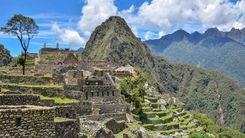Fiestas in Huánuco
If you can, you should aim to be in Huánuco around August 15, when carnival week begins and the city’s normal tranquillity explodes into a wild fiesta binge. Peruvian Independence Day (July 28) is also a good time to be here, when traditional dances like the chunco take place throughout the streets. On January 1, 6 and 18, you can witness the Dance of the Blacks (El Baile de los Negritos) in which various local dance groups, dressed in colourful costumes with black masks (representing the slaves brought to work in the area’s mines) run and dance throughout the main streets of the city; food stalls stay open and drinking continues all day and most of the night.
Temple of Kotosh
Only 6km from Huánuco along the La Unión road, the fascinating, though poorly maintained, TEMPLE OF KOTOSH lies in ruins on the banks of the Río Tingo. At more than 4000 years old, this site predates the Chavín era by more than a thousand years. A more or less permanent settlement existed here throughout the Chavín era (though without the monumental masonry and sculpture of that period) and Inca occupation, right up to the Conquest. The most remarkable feature of the Kotosh complex is the crossed-hands symbol carved prominently onto a stone – the gracefully executed insignia of a very early culture about which archeologists know next to nothing – which now lies in the Museo de Arqueología in Lima. The site today consists of three sacred stone-built enclosures in generally poor condition; but with a little imagination and/or a good local guide, it is both atmospheric and fascinating to explore one of the most ancient temple sites in Peru.
Into the jungle
The Amazon is the obvious place to move on to from Huánuco and the surrounding area, unless you’re heading back to Lima and the coast. The spiralling descent north is stunning, with views across the jungle, as thrilling as if from a small plane. By the time the bus reaches the town of Tingo María, a possible stopover en route to Pucallpa, the Río Huallaga has become a broad tropical river, navigable downstream in shallow canoes or by balsa raft. And the tropical atmosphere, in the shadow of the forested ridges and limestone crags of the Bella Durmiente mountain, is delightful. From Tingo María you can continue the 260km directly northeast on the dirt road through virgin forest, going through the Pass of Padre Abad, with its glorious waterfalls, along the way to Pucallpa, jumping-off point for expeditions deep into the seemingly limitless wilderness of tropical jungle.



